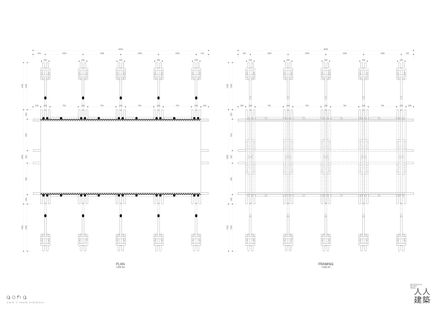Temporary Shelter in Nepal
ARCHITECTS
Charles Lai, Takehiko Suzuki
FUNDED BY
One Village Focus Fund
SPONSORS
Expedia Hong Kong
DESIGN TEAM
Binay, Architecture for the Mass, Eric Ng, Gigi Lee, Timothy Lam, Yorkun Ho, Hari, Bibek, Sujan, Dinesh, Sudip, Prabhakar, Bibhuti, Laxman, Samantha Tang, Lai Pui Tung, Ho Fung Lun
YEAR
2015
AREA
18.0 sqm
LOCATION
Duwakot, Nepal
Text description provided by architect.
Charles Lai from Hong Kong and Takehiko Suzuki from Tokyo, together with Hong Kong based practice aona (atelier of neutral architecture), completed a prototype for a rapid erected shelter for earthquake victims in Nepal with bamboo poles and other locally available materials.
The two architects initiated an architectural relief organization, Architecture for the Mass, in April 2015 in response to the Nepal Earthquake.
One of the obstacles faced by disaster relief agencies in Nepal is that transportations across the mountainous country are of tremendous difficulties.
Many of the road surfaces were not paved properly and were too narrow for trucks with heavy loads.
As a result, even though emergency relief materials such as tents and canvas could be flew into Nepal by cargo planes, these materials can hardly proliferate into the remote villages.
As a result, many families who lost their home have built temporary shelters by themselves.
But apparently its structure is fragile and the space is uncomfortable without proper floors and walls. Mud bricks they use are not earthquake resistant, and dangerous because of its weight. When the monsoon season comes, the heavy rain water can easily come inside.
In response to that, Charles and Takehiko designed a system of bamboo frame structure that could allow shelters to be more comfortable and erected efficiently with materials that are available locally in the villages of Nepal.
Bamboo is a cheap and abundant material in the area, also quite easy to deliver, cut, and assemble.Together with the simple connection details, unskilled workers can assemble the shelter within 2-3 days.
The architects prepared a construction manual that illustrated the assembly methods of the bamboo structural frames. The manual could be transferred through the Internet into regions without construction professionals.
The local could simply follow the manual and assemble the bamboo frames into temporary buildings of various functions, such as shelter, nursery, clinic, community center, etc. without the help from construction professionals.
To prepare for the rain during the monsoon season, the sectional profile of the frames consists of a raised platform and a pitched roof design to keep the interior dry. The diagonal elements provide rigidity to the frame and improve the quake resistant ability of the structure.
Depending on the availability of building materials, metal sheets, canvas, or bamboo strips could be used to construct the envelope of the structure.
The prototype was built in the village of Duwakot in collaboration with One Village Focus Fund in Hong Kong.A team of 10 volunteers and 4 paid workers constructed the prototype in 2 days.
Timber and metal sheets from the damaged houses were reused to construct the envelope of the shelter. The cost of the 3m x 6m shelter is around US$400 -$ 500. The bamboo structural frame could be appropriated into different sizes depending on the function of the structure.
Charles and Takehiko anticipate the prototype to provide an alternative solution for temporary shelters in Nepal. The local can assimilate the design of the prototype and produce evolved designs based on its principle.
The aim is to equip general households with the tools and methods to erect their own temporary structures. Potentially, the design can empower the local community to establish a self-help network among themselves and speedup the recovery from the disaster.
The design can empower the local community to establish a self-help network among themselves and speedup the recovery from the disaster.
After the development and construction of the temporary structure prototype, Architecture for the mass will focus on reconstruction of schools and community facilities in severely damages regions of Gorkha, Katunge and Bhaktapur regions.























